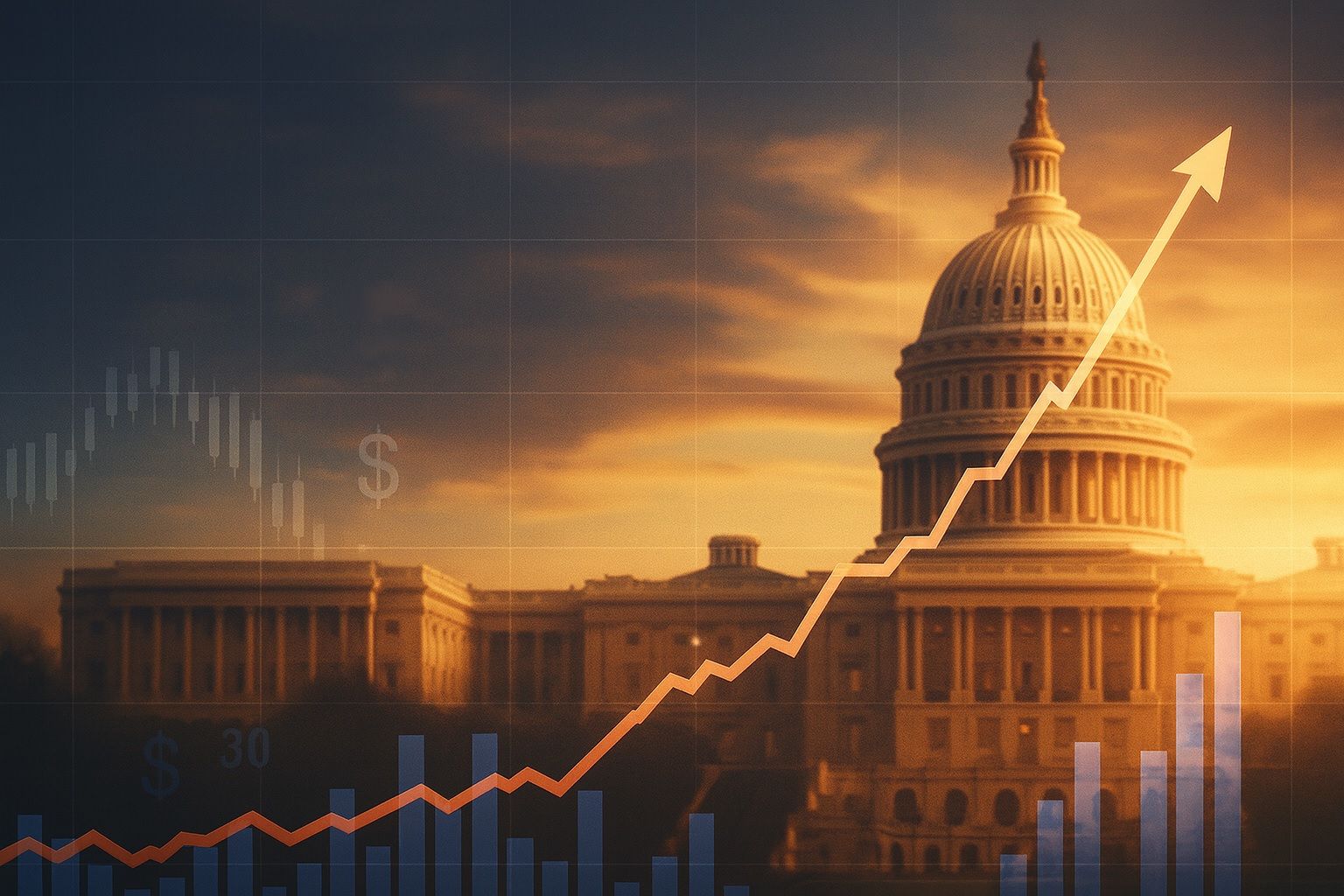- Historic Yield Spike: The benchmark U.S. 10-year Treasury yield jumped to about 4.01% on Oct 17, 2025, its highest level in roughly 17 years [1] [2]. (It briefly surged to ~4.85% amid hotter-than-expected inflation data [3].)
- Mortgage Rates Rising: As a result, long-term borrowing costs have climbed. The 30-year fixed mortgage rate is near 6.23% (Oct 17 quote) – only modestly below recent highs but up from ~6.1% in late September [4] [5]. Homebuyers now face higher monthly payments.
- Stock Market Reaction: Wall Street ended Oct 17 modestly higher (Dow +0.52% to 46,190.61, S&P 500 +0.53% to 6,664.01, Nasdaq +0.52% to 22,679.98 [6]) as trade and bank fears eased. But volatility is up: tech/growth stocks sensitive to rates are vulnerable. Gold, a safe haven, fell from record highs (~$4,300/oz) as yields and the dollar firmed [7].
- Federal Reserve Stance: Fed Chair Jerome Powell reiterated a “meeting-by-meeting” approach to cuts, balancing weaker job market data against 2%-plus inflation. Notably, Powell hinted the Fed may end its balance-sheet runoff (“QT”) soon – a signal that helped pull the 10-year yield down to ~4.02% on Oct 14 [8]. However, persistent inflation pressures quickly sent yields back up. Markets still see about two rate cuts by year-end, but Fed officials remain cautious.
- Winners & Losers: Strategists warn that rising yields create a clear split. Borrowers and high-debt firms face headwinds: homebuilders and REITs (e.g. D.R. Horton, Lennar) will feel the pinch as mortgage demand slows and financing costs rise [9]. Utilities (NextEra, Duke) and other capital-intensive companies also face higher borrowing costs [10]. By contrast, banks and cash-rich companies may benefit from wider interest margins. Large lenders (JPMorgan Chase, Bank of America) could see earnings tick up as loan rates rise faster than deposit rates [11]. Big tech (Apple, Microsoft), with huge cash reserves, are less rate-sensitive on earnings [12].
- Outlook & Forecast: Many strategists expect yields to eventually retreat. For example, UBS analysts forecast the 10-year yield will end 2025 around 4.0% (and fall to ~3.75% by mid-2026) [13] as economic growth softens. However, the path is uneven: “large budget deficits and any Fed capitulation to inflation could push yields higher,” say market observers [14]. In the short term, markets will watch key data (CPI, jobs, Fed speak). A surprise spike in inflation or renewed trade tensions could send yields even higher, while signs of economic cooling could pull them back.
Why the 10-Year Yield Is So High
The recent surge in the 10-year yield reflects a tug-of-war between inflation fears and hopes for easing policy. Stronger-than-expected inflation data and durable growth have led investors to demand more return on long-term loans. “The immediate market reaction was a swift surge in the 10-year Treasury yield, breaching 4.85%, the highest since 2008,” reports market analyst Huzaifa Z on Meyka [15]. In early October, yields had spiked to near 4.78% (the highest since 2007 [16]) before pulling back. By Oct 13 they were around 4.03% [17], and after Powell’s dovish comments on Oct 14 they dipped to ~4.02% [18]. Traders still see some rate cuts ahead – “market pricing still sees more rate cuts on the way (one more 25‑bp cut by year-end)” [19] – but the current yield level implies investors want a higher premium for inflation and government debt. Heavy U.S. deficits and even looming tariff threats are keeping long-term yields “elevated” [20].
“We forecast the US 10-year yield at 4.0% at end-2025, and 3.75% by mid-2026,” says UBS’s Chief Investment Office [21], reflecting expected Fed easing. But one strategist cautions that forecasts “could be altered by stronger jobs numbers or hot inflation readings” [22]. In other words, the outlook is data-dependent: if inflation stubbornly refuses to fall, yields could stay higher longer.
Impact on Borrowers and Mortgage Rates
Higher Treasury yields quickly flow through to consumer borrowing costs. Mortgage News Daily notes that 10-year yields around 4.03% on Oct 15 represented the best levels since mid-September, and mortgage-backed securities prices were at four-week highs [23]. This helped keep 30-year mortgage rates steady near 6.23% (as of Oct 17) [24] – still elevated by historic standards (vs. ~3% a few years ago) but roughly flat from recent weeks. In practical terms, a $300,000 home loan at 6.23% costs about $400 more per month than at 5.75%. As MarketMinute notes, a jump in the 10-year yield “translates directly into higher costs for long-term borrowing, impacting everything from mortgage rates to corporate debt issuance” [25].
Housing analysts are already seeing signs of strain. Higher rates tend to “deter potential buyers” and slow home sales, which in turn pressures homebuilder profits [26]. If yields stay high, construction projects can become more expensive. This is one reason why builder stocks have lagged recently. Consumers and businesses that rely on loans (auto, student loans, corporate debt) also feel the pinch when the Treasury yield climbs. Refinancing activity has been muted, and more homeowners and companies may hold off on borrowing or investment until rates fall.
Equity Markets and Safe-Havens
After weeks of choppy trading, U.S. stocks ended slightly higher on Oct 17 as some fears (banking stress, trade tensions) eased [27] [28]. The “flight to quality” that had driven yields down earlier reversed, so bond prices fell and yields rose. The S&P 500 and Dow Industrials each gained about 0.5% on Oct 17 [29], leaving them modestly up for the week. Technology and high-growth sectors saw more volatility; these stocks are highly rate-sensitive, as higher rates diminish the present value of future earnings. By contrast, value sectors like banking held up: banks benefit from rising lending rates, and indeed JPMorgan and Bank of America have seen their net interest margins improve.
Gold’s spectacular rally — touching fresh highs above $4,300 an ounce last week — paused as yields and the dollar firmed. On Oct 17 gold fell about 2% to ~$4,230 [30]. The pullback likely reflects a reversal of the safe-haven bid (investors shifted from gold back into Treasuries and dollar). However, many still view gold as a hedge against inflation; UBS even forecasts gold could climb toward $4,700 if real yields turn deeply negative [31].
Across markets, sentiment remains fragile. Fed observers caution that until inflation decisively cools, any data surprises (especially inflation metrics) could whip bonds and stocks around. Callie Cox, chief strategist at Ritholtz Wealth, notes Powell’s hint at ending the Fed’s balance-sheet run-off “is a hidden source of relief – especially to homeowners – that rate cuts alone may not be able to deliver” [32]. In other words, shrinking the Fed’s bond holdings puts downward pressure on yields independently of rate cuts. Still, Cox and others stress that inflation is still above 2%, so Powell will be “data-dependent”. On Oct 14, Chris Grisanti of MAI Capital called Powell’s tone “somewhat more dovish than I expected,” saying it boosts “confidence in rate cuts coming before the end of the year” [33].
What Comes Next?
Going forward, markets will key on new inflation readings, retail sales, and Fed communications. If inflation data (CPI, PCE) show more stickiness, that could fuel another leg up in yields (the 10-year could test back toward 4.5%). Conversely, any softening in growth or inflation could prompt a pullback toward the 3.75–4.0% range that many forecasters expect [34]. The Bloomberg and Reuters consensus still forecasts at least two rate cuts by end-2025, suggesting a gradual easing of long-term rates.
Investors and consumers are advised to prepare for continued volatility. Homeowners and homebuyers may face higher rates for some time, while companies should lock in financing rates soon if possible. As one strategist puts it, the current climate requires a “Swiss Army approach” – balancing cash, stocks, and bonds carefully [35].
Sources: Reuters, Mortgage News Daily, MarketMinute, TechStock² (ts2.tech), Meyka, UBS [36] [37] [38] [39] [40] [41] [42] [43]. These publications provided the latest market data, expert commentary, and analysis on yields, Fed policy, mortgage rates, and stock-market reactions.
References
1. business.kanerepublican.com, 2. meyka.com, 3. meyka.com, 4. www.mortgagenewsdaily.com, 5. ts2.tech, 6. www.reuters.com, 7. www.reuters.com, 8. www.reuters.com, 9. business.kanerepublican.com, 10. business.kanerepublican.com, 11. business.kanerepublican.com, 12. business.kanerepublican.com, 13. www.ubs.com, 14. ts2.tech, 15. meyka.com, 16. ts2.tech, 17. ts2.tech, 18. www.reuters.com, 19. ts2.tech, 20. ts2.tech, 21. www.ubs.com, 22. www.reuters.com, 23. www.mortgagenewsdaily.com, 24. www.mortgagenewsdaily.com, 25. business.kanerepublican.com, 26. business.kanerepublican.com, 27. www.reuters.com, 28. www.reuters.com, 29. www.reuters.com, 30. www.reuters.com, 31. www.ubs.com, 32. www.reuters.com, 33. www.reuters.com, 34. www.ubs.com, 35. www.reuters.com, 36. www.reuters.com, 37. www.reuters.com, 38. business.kanerepublican.com, 39. meyka.com, 40. www.mortgagenewsdaily.com, 41. ts2.tech, 42. www.ubs.com, 43. business.kanerepublican.com









